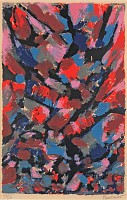BIOGRAPHY

Alfred Manessier (French 1911-1993)
Alfred Manessier was born on December 5, 1911 in Saint-Ouen, Somme department, just north of Paris, France, the only son of a wholesale wine merchant. His paternal grandfather was a designer and cutter of ornamental building stone. He grew up in Abbeville and Amiens and at the fishing port of Le Crotoy, where he visited his maternal grandmother who was a ropemaker. There he painted pictures of fishing boats and the bay of the river Somme; he responded to the play of light over the river.
Manessier attended the Lycee and the Ecole des Beaux-Arts, in Amiens, where he studied architecture, then on to the Ecole des Beaux-Arts in Paris, but he disliked the atmosphere of the school and spent most of his time in the Louvre, copying paintings by Tintoretto and Rembrandt. At the art academies of Montparnasse he found greater freedom of expression, and under the influence of Bissiere, turned from realistic landscapes to painting in the cubist tradition. Manessier left Paris after his father died in 1936. He began turning toward Surrealism about that time.
In October 1938 Manessier married Therese Simonet. They had two children, born in 1940 and 1947. He served in the French Army in 1939 and 1940. During a brief visit to the Somme in 1943, while staying in the Grand Trappist Monastery, he underwent a reconversion to Roman Catholicism. As a result he settled for a while in Bignon, Normandy, where, in accordance with the growing "inwardness" of his vision, he painted compositions with dramatic lighting recalling Georges de la Tour. He designed stained glass windows and tapestries, also a series of lithographs with Easter themes.
